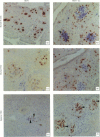Abstract
The role of immune complexes (Icx) in B-cell memory formation and affinity maturation allow for their potential use as vaccines. Recently, a new immune complex vaccine has been developed that is currently under field trials conducted in commercial poultry. This immune complex vaccine is developed by mixing live intermediate plus infectious bursal disease virus (IBDV) with hyperimmune IBDV chicken serum (IBDV-Icx vaccine). Here we have investigated the infectivity of this vaccine as well as the native IBDV (uncomplexed) vaccine in terms of differences in target organs, in target cells and speed of virus replication. At various days after inoculation on day 18 of incubation (in ovo) with either one dose of virus alone or the IBDV-Icx vaccine, the replication of IBDV and the frequency of B cells and other leucocyte populations were examined in the bursa of Fabricius, spleen, and thymus using immunocytochemistry. With both vaccines, IBDV was detected associated with B cells, macrophages and follicular dendritic cells (FDC) in bursa and spleen, although complexing IBDV with specific antibodies caused a delay in virus detection of about 5 days. Most remarkable was the low level of depletion of bursal and splenic B cells in IBDV-Icx vaccinated chickens. Furthermore, in ovo inoculation with the IBDV-Icx vaccine induced more germinal centres in the spleen and larger amounts of IBDV were localized on both splenic and bursal FDC. From these results we hypothesize that the working mechanism of the IBDV-Icx vaccine is related to its specific cellular interaction with FDC in spleen and bursa.
Full text
PDF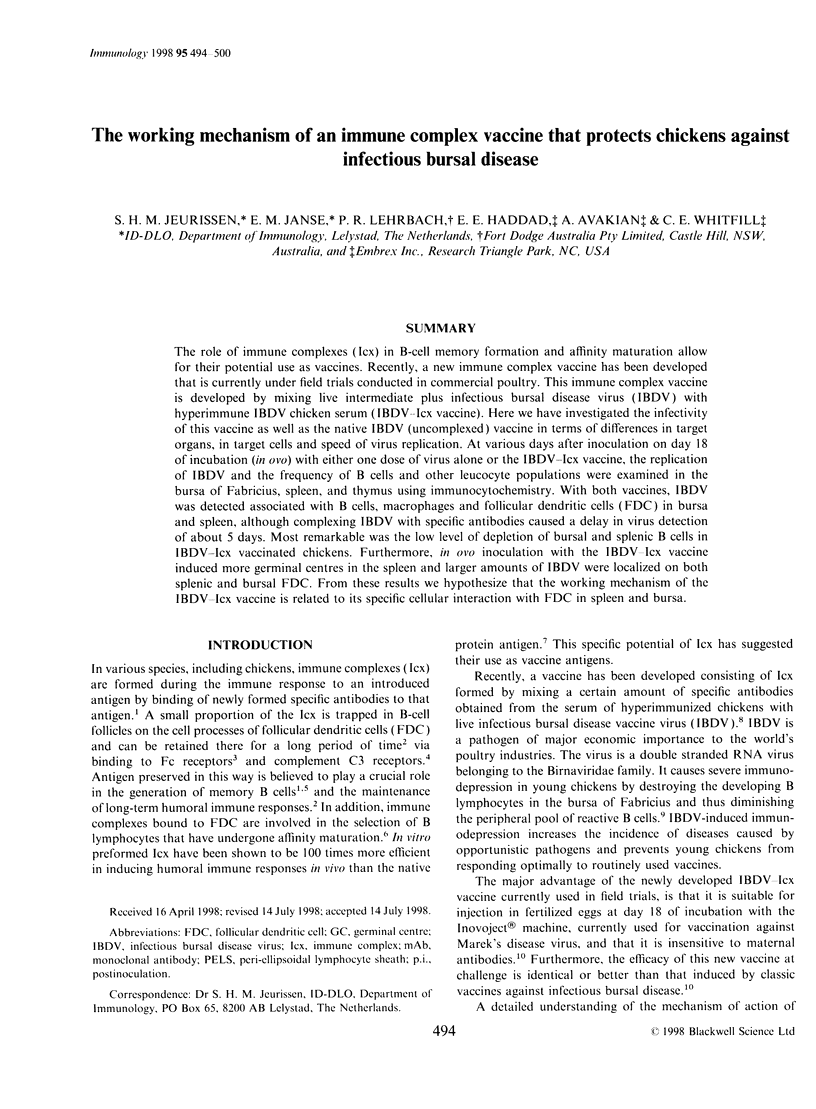
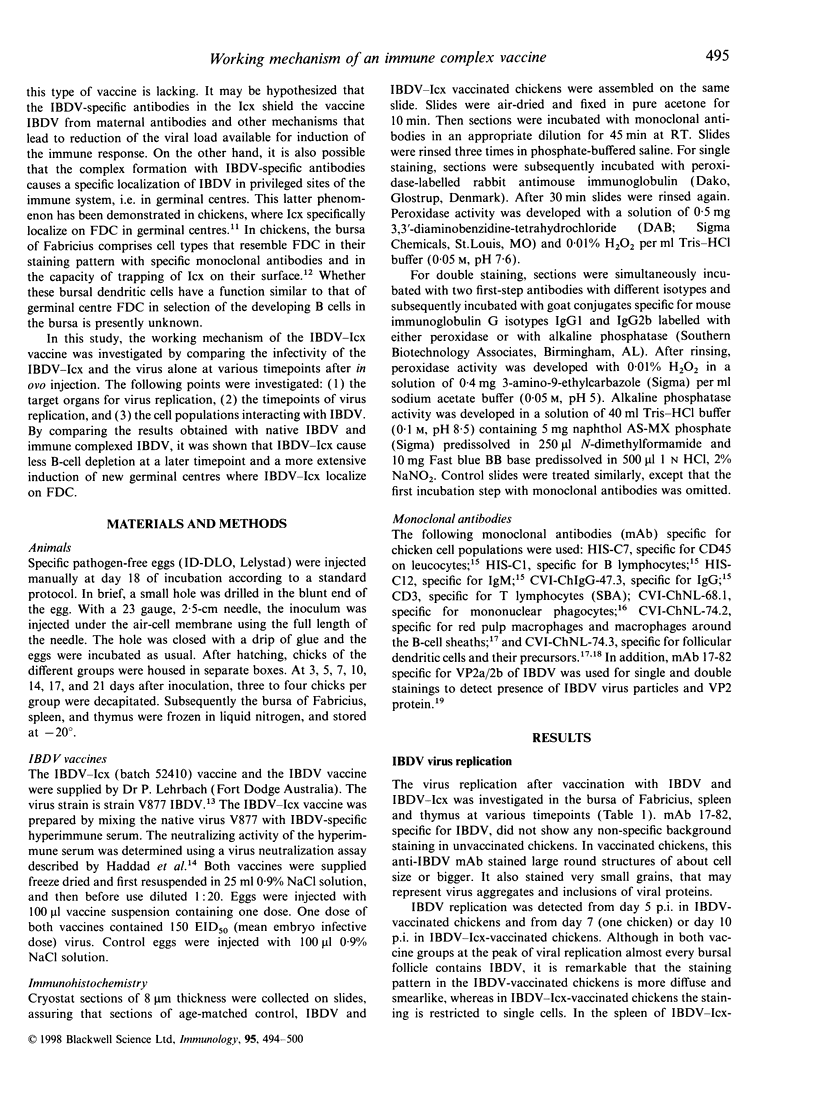
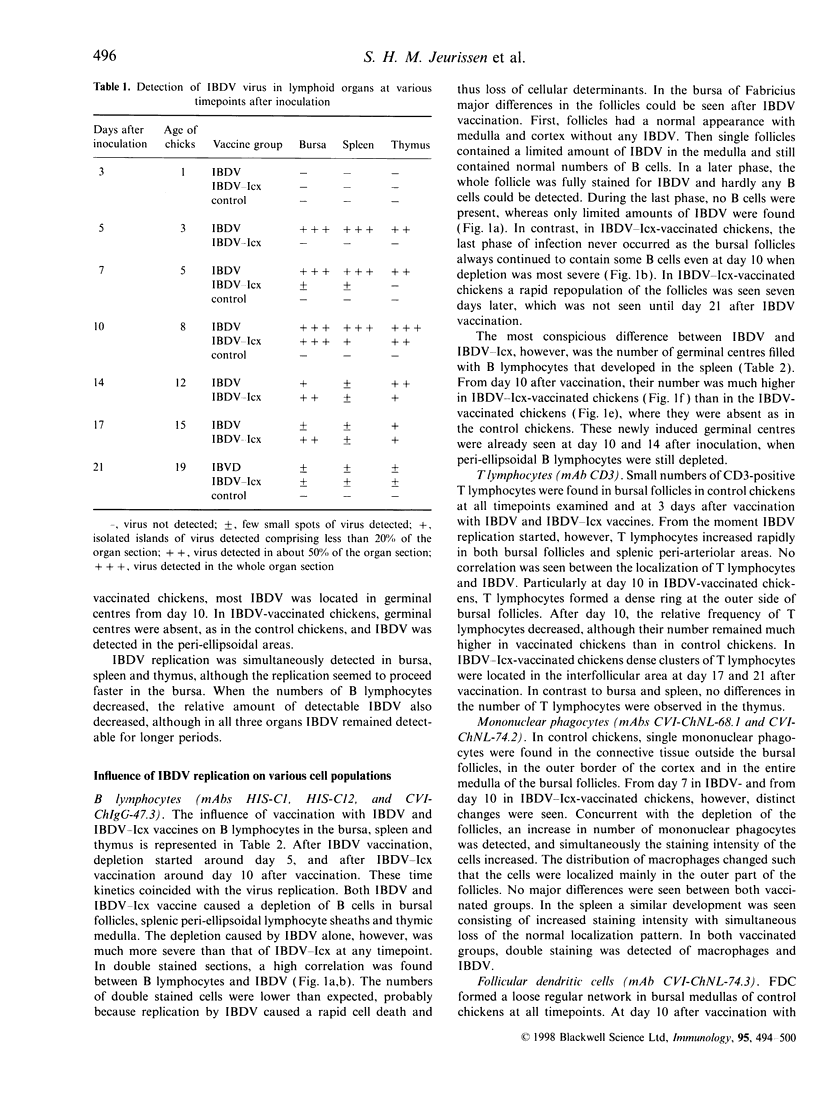
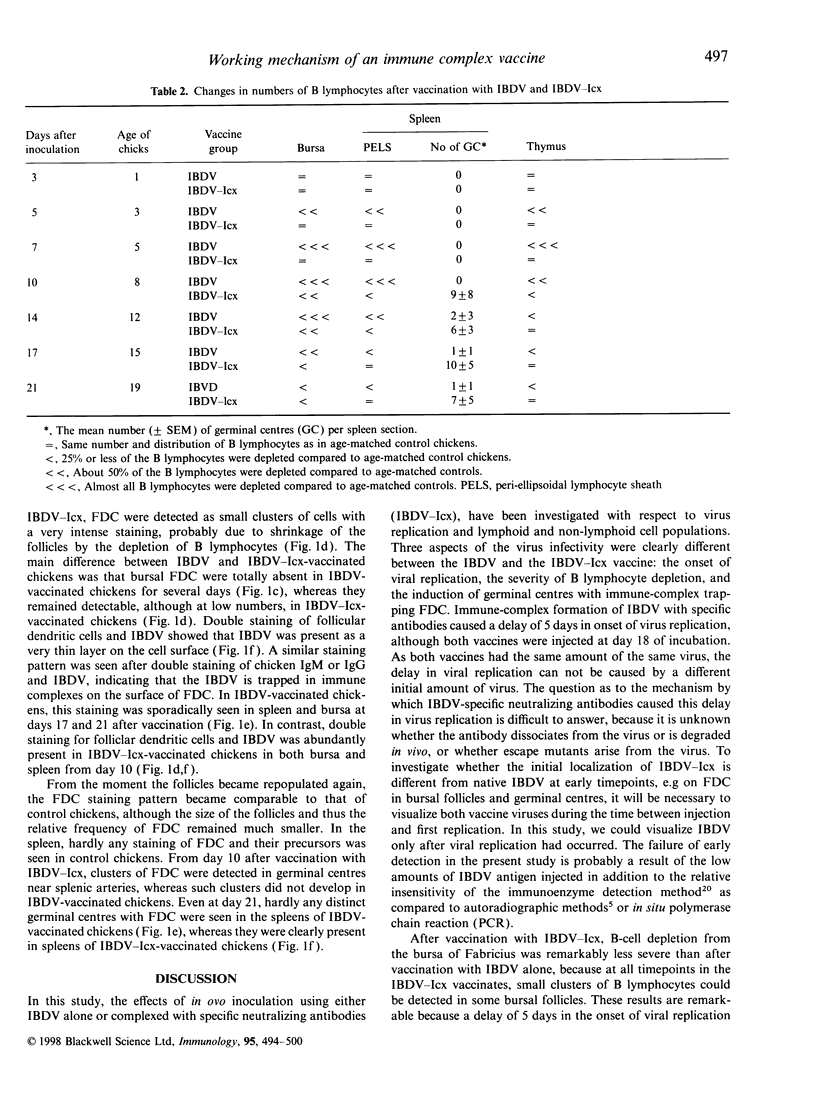
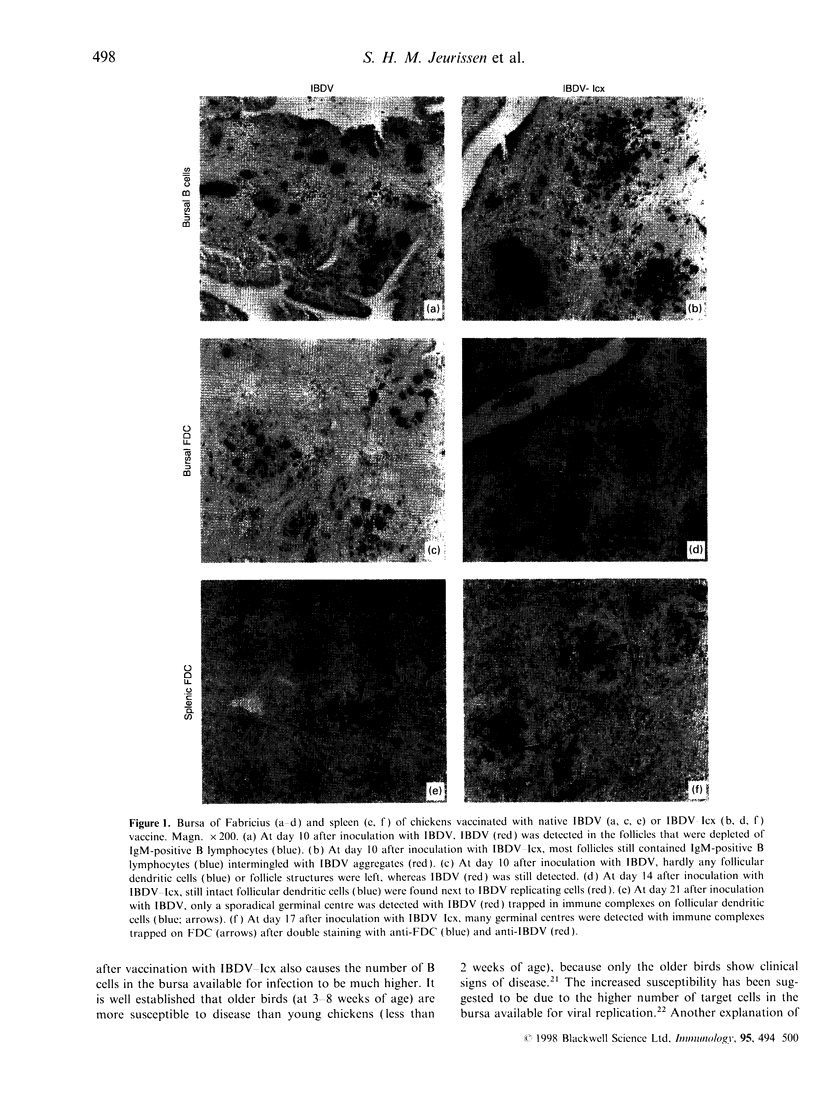
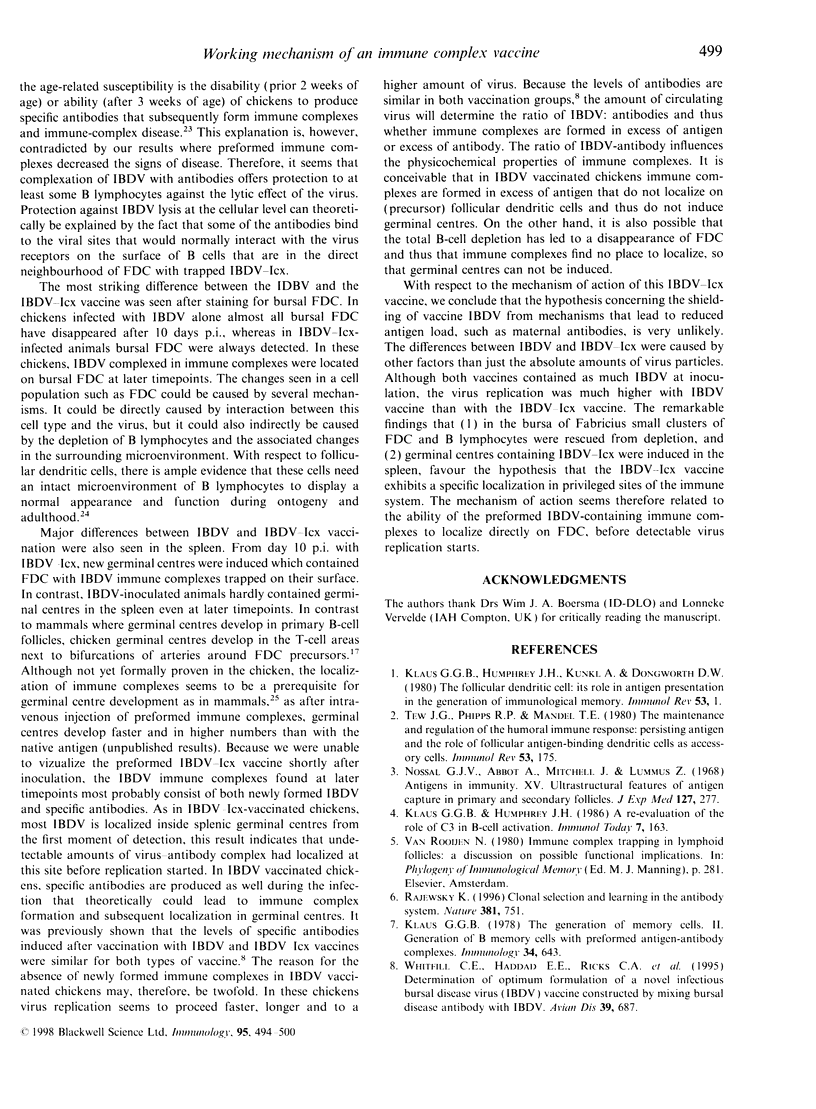
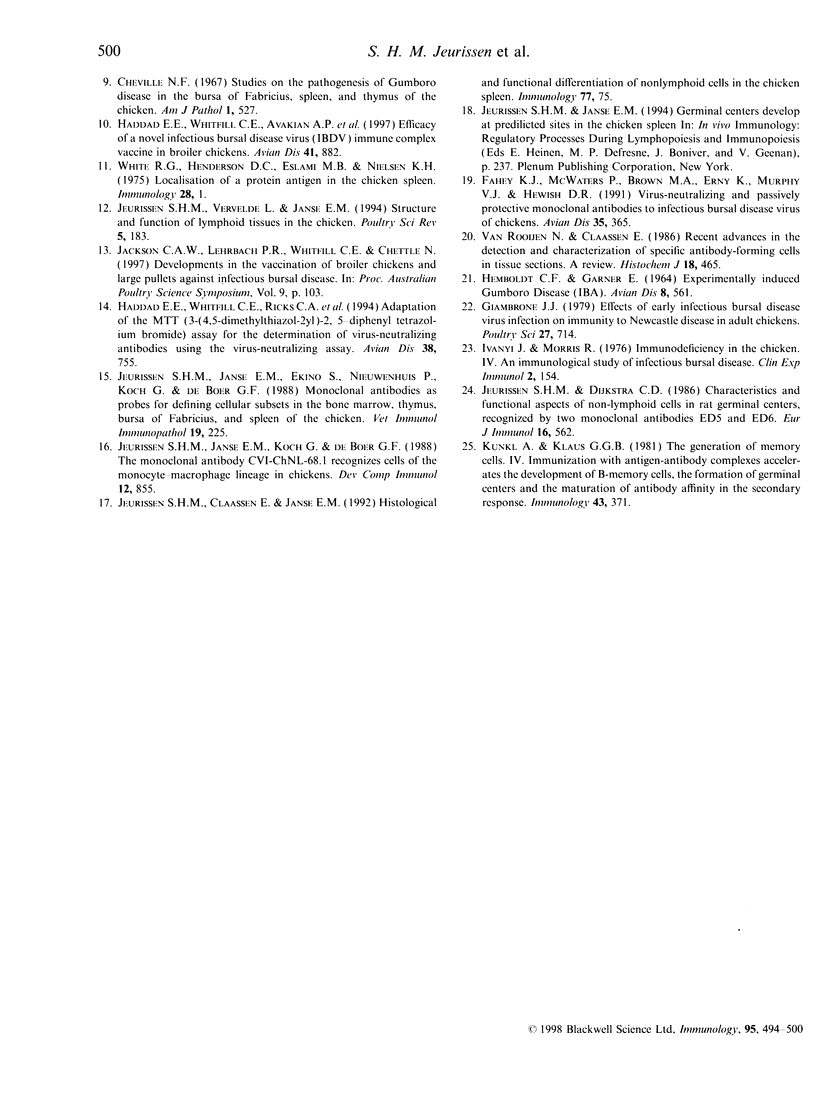
Images in this article
Selected References
These references are in PubMed. This may not be the complete list of references from this article.
- Cheville N. F. Studies on the pathogenesis of Gumboro disease in the bursa of Fabricius, spleen, and thymus of the chicken. Am J Pathol. 1967 Oct;51(4):527–551. [PMC free article] [PubMed] [Google Scholar]
- Fahey K. J., McWaters P., Brown M. A., Erny K., Murphy V. J., Hewish D. R. Virus-neutralizing and passively protective monoclonal antibodies to infectious bursal disease virus of chickens. Avian Dis. 1991 Apr-Jun;35(2):365–373. [PubMed] [Google Scholar]
- Haddad E. E., Whitfill C. E., Avakian A. P., Ricks C. A., Andrews P. D., Thoma J. A., Wakenell P. S. Efficacy of a novel infectious bursal disease virus immune complex vaccine in broiler chickens. Avian Dis. 1997 Oct-Dec;41(4):882–889. [PubMed] [Google Scholar]
- Haddad E. E., Whitfill C. E., Ricks C. A., Fredericksen T., Rowe D., Owen L., Baldridge A., Murray L., Thoma J. A. Adaptation of the MTT (3-(4,5-dimethylthiazol-2-yl)-2,5-diphenyl tetrazolium bromide) assay for the determination of virus-neutralizing antibodies using the virus-neutralization assay. Avian Dis. 1994 Oct-Dec;38(4):755–761. [PubMed] [Google Scholar]
- Ivanyi J., Morris R. Immunodeficiency in the chicken. IV. An immunological study of infectious bursal disease. Clin Exp Immunol. 1976 Jan;23(1):154–165. [PMC free article] [PubMed] [Google Scholar]
- Jeurissen S. H., Claassen E., Janse E. M. Histological and functional differentiation of non-lymphoid cells in the chicken spleen. Immunology. 1992 Sep;77(1):75–80. [PMC free article] [PubMed] [Google Scholar]
- Jeurissen S. H., Dijkstra C. D. Characteristics and functional aspects of nonlymphoid cells in rat germinal centers, recognized by two monoclonal antibodies ED5 and ED6. Eur J Immunol. 1986 May;16(5):562–568. doi: 10.1002/eji.1830160518. [DOI] [PubMed] [Google Scholar]
- Jeurissen S. H., Janse E. M., Ekino S., Nieuwenhuis P., Koch G., De Boer G. F. Monoclonal antibodies as probes for defining cellular subsets in the bone marrow, thymus, bursa of fabricius, and spleen of the chicken. Vet Immunol Immunopathol. 1988 Oct;19(3-4):225–238. doi: 10.1016/0165-2427(88)90110-9. [DOI] [PubMed] [Google Scholar]
- Jeurissen S. H., Janse E. M., Koch G., de Boer G. F. The monoclonal antibody CVI-ChNL-68.1 recognizes cells of the monocyte-macrophage lineage in chickens. Dev Comp Immunol. 1988 Fall;12(4):855–864. doi: 10.1016/0145-305x(88)90059-6. [DOI] [PubMed] [Google Scholar]
- Klaus G. G. The generation of memory cells. II. Generation of B memory cells with preformed antigen-antibody complexes. Immunology. 1978 Apr;34(4):643–652. [PMC free article] [PubMed] [Google Scholar]
- Kunkl A., Klaus G. G. The generation of memory cells. IV. Immunization with antigen-antibody complexes accelerates the development of B-memory cells, the formation of germinal centres and the maturation of antibody affinity in the secondary response. Immunology. 1981 Jun;43(2):371–378. [PMC free article] [PubMed] [Google Scholar]
- Nossal G. J., Abbot A., Mitchell J., Lummus Z. Antigens in immunity. XV. Ultrastructural features of antigen capture in primary and secondary lymphoid follicles. J Exp Med. 1968 Feb 1;127(2):277–290. doi: 10.1084/jem.127.2.277. [DOI] [PMC free article] [PubMed] [Google Scholar]
- Rajewsky K. Clonal selection and learning in the antibody system. Nature. 1996 Jun 27;381(6585):751–758. doi: 10.1038/381751a0. [DOI] [PubMed] [Google Scholar]
- Van Rooijen N., Claassen E. Recent advances in the detection and characterization of specific antibody-forming cells in tissue sections. Histochem J. 1986 Sep;18(9):465–471. doi: 10.1007/BF01675613. [DOI] [PubMed] [Google Scholar]
- Whitfill C. E., Haddad E. E., Ricks C. A., Skeeles J. K., Newberry L. A., Beasley J. N., Andrews P. D., Thoma J. A., Wakenell P. S. Determination of optimum formulation of a novel infectious bursal disease virus (IBDV) vaccine constructed by mixing bursal disease antibody with IBDV. Avian Dis. 1995 Oct-Dec;39(4):687–699. [PubMed] [Google Scholar]



